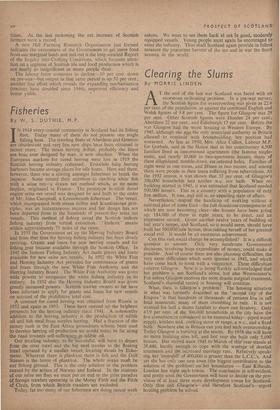Agriculture and Forestry
By ROBERT URQUHART IT is possibly true to say that Scotland's two great sister industries of agriculture and forestry are living a more harmonious family life than they did, say, in the first few Post-war years. We can still hear the voice of the Highland and Border farmer raised against the march of the trees but I seem to detect a little more tolerance today, because, first, It is recognised that we must have more home timber to save hard currency, and, second, the Forestry Commission is in fact more alive to the need for fitting into the general pattern Which forestry and farming make on the countryside. The sometimes heated squabbling that arose in the difficult Post-war years was the natural result of the collision of interests of two great industries from which the nation demanded a vast expansion. Both have expanded and are still expanding, to their own credit and the nation's lasting benefit. Of Scotland's total area of 19,000,000 acres there is the relatively large pro- Portion of land described as •' rough grazings.' covering some 11,000,000 acres. It is on areas of this land that foresters and farmers join battle. What do the foresters want ? The aim is to get ultimately a national forest in Britain Of 5,000,000 acres and Scotland is expected to provide half of it. The li million acres still to be found must come from the 11,000,000 acres of 'tough grazings '—a term which is Often little more than a euphemism. Alongside the problem of getting this land without treading on too many agricultural toes IS that arising from the very success of the Commission in Populating the Highlands with little forest communities. The Problem is employment for the families of foresters. Light woodcraft industries, such as toymaking, are among the main 11, ones but everything depends on whether the girls will stay in these villages, for if they head for the towns the boys go too. As the Commission push out into that second li million acres they will no doubt meet some opposition, but the nation needs wood as well as mutton. Of one thing we can be sure and that is that we shall see no more of those miles-long blocks of trees along hillsides, which sterilised the upper graz- ings in the summer by keeping the sheep from reaching them. Wide rides are now left to allow the stock to get up from the low lands.
Today, as the farmer emerges from the controlled economy to the free market, new problems face him almost daily. Scot- land shares those problems with English farming, with one big difference—distance from markets, a potent point in these days of high freight charges. So far as quality beef is ccin- eerned there is hope that once more 'Prime Scotch' or 'Aber- deen Killed' will be labels s to conjure with in the minds of the housewives of London and the other big Consuming centres. To that extent quality will get its reward and probably over- come the disadvantage of distance. Northern Ireland has received freight concessions and the distant isles of Orkney and Shetland are now looking for similar treatment. Orkney, especially, deserves recognition for the hard work and enter- prise of the people of these windswept and,agriculturally un- 'Promising isles Which have achieved, from Orkney alone, an annual output of some 60 million eggs worth about £1,000,000, a magnificent effort, which along with fine work in cattle, sheep and pig production as well as land reclamation has redounded tO the everlasting credit of Britain's 'Little Denmark.' , Generally the impact of the new freedom—or the ' threat ' of It----will take sonie time to show in Scottish farming, but latest figures show that not even the hint of coming changes has had deep reaching effect. Beef cattle are up 10 per cent. on 1952 and it may be said generally that stock has increased while crops have decreased a little, a natural outcome of the changing times. At the last reckoning the net incomes of Scottish farmers were a record.
A new Hill Farming Research Organisation just formed indicates the earnestness of the Government to get more food from. our marginal lands and just out is the long-awaited Report of the Inquiry into'Crofting Conditions, which focusses atten- tion, on a segment of Scottish life and food production which is not nearly so insignificant as many people think.
The labour force continues to decline-10 per cent. down on pre-war—but output in that same period is up 52 per cent., another fine effort which reveals the expanding mechanisation (tractors have doubled since 1946), improved efficiency and better yields.



































































 Previous page
Previous page